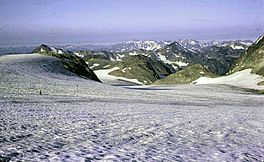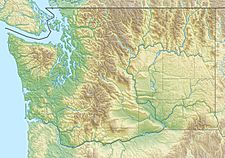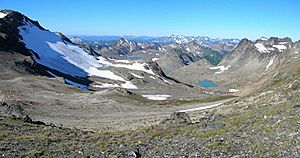White Chuck Glacier facts for kids
Quick facts for kids White Chuck Glacier |
|
|---|---|

Northern lobe of White Chuck Glacier as seen in 1973
|
|
| Type | Mountain glacier |
| Coordinates | 48°03′53″N 121°06′57″W / 48.06472°N 121.11583°W |
| Area | .54 sq mi (1.4 km2) in 2005 |
| Length | .75 mi (1.21 km) |
| Terminus | Icefall/Barren Rock |
| Status | Retreating |
The White Chuck Glacier is a large ice formation found in the Glacier Peak Wilderness area. This wilderness is a special protected region in the U.S. state of Washington. The glacier is about 3.5 miles (5.6 km) south of a tall mountain called Glacier Peak.
This glacier is part of the Mount Baker-Snoqualmie National Forest. It is very close to another glacier, the White River Glacier. A narrow, rocky ridge, called an arête, separates them.
How White Chuck Glacier Is Changing
The White Chuck Glacier has been shrinking a lot. This shrinking has happened since the end of a period known as the Little Ice Age. The Little Ice Age was a time from about the 1300s to the mid-1800s when parts of the world were cooler.
Glacier Retreat Over Time
From around 1850 to 1930, the glacier became thinner. By 1940, it started to shrink much faster. By 1955, the glacier had split into three separate ends, called termini. A terminus is the very end of a glacier. By 2005, the northernmost end of the glacier had completely disappeared.
As the glacier has shrunk, it has left behind several small lakes. These are called proglacial lakes because they form in front of a melting glacier. Between 1958 and 2005, the White Chuck Glacier lost more than half of its total surface area. This shows how quickly it is changing.



